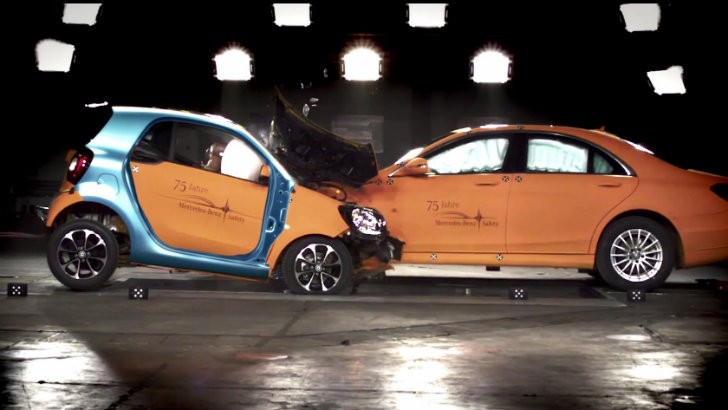One of them is a full-size sedan that weighs 2 tons (4,409 lbs) or so, while the other is a teeny-weeny city car that tips the scale at under 1,000 kilograms (2,204 lbs). The first of them is heralded as one of the most technologically advanced, luxurious and safest vehicles in the world, while the other is a funky urban cruiser smaller in dimensions than a MINI Cooper.
Based on elementary understanding of how physics work in a head-on collision between two cars, you would bet that the Mercedes-Benz S-Class is much more protective than the all-new smart fortwo. The safety principle behind the S-Class is a very rigid passenger cell construction, while the fortwo's occupants are protected by a tridion safety cell.
Basically, the tridion cell design employs ultra-high strength hot-formed steels and maximum-strength multiphase steel and acts like safety cage. This contraption is able to prevent major deformation even in very severe collisions, thus helping to protect the occupants' space. The fuel tank is located safely outside the deformation zone in front of the rear axle. As if that wasn't enough, both the fortwo and forfour come as standard with driver airbag, driver kneebag and front passenger airbag.
That may not sound like much of a difference in a 50 km/h (31 mph) frontal collision between the S-Class and the all-new fortwo. In addition to that, crash test dummies and other equipment added significant weight to both cars, with the smart tipping the scale at 1,124 kgs (2,478 lbs) and the Mercedes at 2,308 kgs (5,088 lbs). Nevertheless, the results speak for themselves - despite its size, the smart fortwo offers its two passengers an intact occupant space and excellent chances of survival because it has undergone the same development programme as the new Mercedes-Benz S or C-Class.
"The well-proven tridion cell forms the basis for the high crash safety of the new smart. It ensures efficient energy absorption in a frontal impact. To this end, the crumple zones of the new smart have been made as large as possible. Homogeneous application of force in the structure is achieved with several load paths", declared Professor Rodolfo Schoneburg, head of vehicle safety at Mercedes-Benz Cars.
Basically, the tridion cell design employs ultra-high strength hot-formed steels and maximum-strength multiphase steel and acts like safety cage. This contraption is able to prevent major deformation even in very severe collisions, thus helping to protect the occupants' space. The fuel tank is located safely outside the deformation zone in front of the rear axle. As if that wasn't enough, both the fortwo and forfour come as standard with driver airbag, driver kneebag and front passenger airbag.
That may not sound like much of a difference in a 50 km/h (31 mph) frontal collision between the S-Class and the all-new fortwo. In addition to that, crash test dummies and other equipment added significant weight to both cars, with the smart tipping the scale at 1,124 kgs (2,478 lbs) and the Mercedes at 2,308 kgs (5,088 lbs). Nevertheless, the results speak for themselves - despite its size, the smart fortwo offers its two passengers an intact occupant space and excellent chances of survival because it has undergone the same development programme as the new Mercedes-Benz S or C-Class.
"The well-proven tridion cell forms the basis for the high crash safety of the new smart. It ensures efficient energy absorption in a frontal impact. To this end, the crumple zones of the new smart have been made as large as possible. Homogeneous application of force in the structure is achieved with several load paths", declared Professor Rodolfo Schoneburg, head of vehicle safety at Mercedes-Benz Cars.


